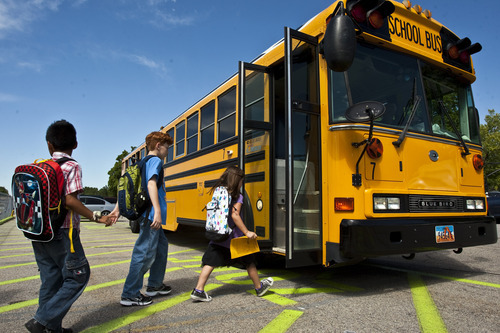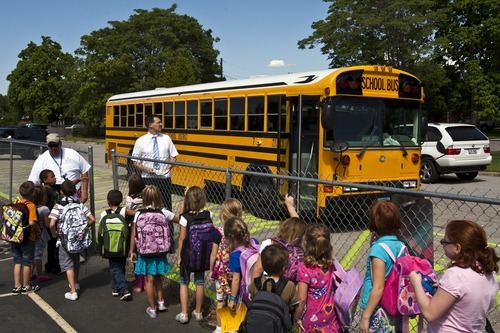This is an archived article that was published on sltrib.com in 2011, and information in the article may be outdated. It is provided only for personal research purposes and may not be reprinted.
Pat O'Hara was accustomed to fielding complaints about the pollution spewing from Murray School District buses. The district's support services chief has seen the calls die down thanks to the state's four-year effort to turn Utah's diesel school bus fleet green.
"Now, when the buses depart from a stop light, [nearby drivers] don't see a big belch of black smoke," he said. "The buses are a lot cleaner."
The program is ending after retrofitting 1,200 dirty buses and replacing 27 of the oldest ones. The total cost is about $6 million, paid for by state agencies, the districts and the U.S. Environmental Protection Agency. The total pollution avoided is more than 6,700 tons over the life of the fleet.
EPA made cleaning up school buses a priority a few years ago, not only because of the dirty emissions the buses cough into the air but also because of the health impact on the 24 million schoolchildren who ride buses each day. The buses cover about 4 billion miles a year, according to the agency.
"Diesel emissions are one of the most challenging and important public health issues facing the country," Jim Blubaugh, head of the EPA's National Clean Diesel Program, told the The Washington Post last year. "It's difficult because diesel engines are the work horse of the country."
Utah's program, led by the Utah Division of Air Quality (DAQ), focused on two key strategies for reducing pollution from diesel buses: eliminating unnecessary idling and applying a technology fix, either by replacing or retrofitting dirty buses to cut emissions.
DAQ's Mat Carlile said the federal money, plus matching funds provided by his agency, the Legislature, the Utah Department of Transportation and the school districts, made it possible to improve air quality, especially for children, whose lungs are particularly vulnerable to pollution.
Older buses had exhaust systems that allowed fumes to circulate in the cabins, where bus-riding students spend an average of 30 minutes to one hour a day, according to EPA.
"It was great," said Carlile, "to help kids breathe easier."
Michelle Hofmann, a Salt Lake City pediatrician who worked with DAQ to secure the federal grants and local matching funds, said harnessing the know-how and commitment of all the stakeholders was key to the program's success. Once they realized the funding was available and that there was broad community support for the clean-diesel program, everybody pitched in to persuade the EPA to grant the state about $4 million for the buses.
"It's kind of hard to argue against cleaning up a school bus and the positive health impacts," said Hofmann, a founder of Breathe Utah. and mother of a child with asthma.
Hofmann also pointed to the clean-diesel buses as an example of a practical solution for addressing one of the community's most daunting problems: improving air quality.
"There are things you can do," she said. "As individuals you can have a real impact."
fahys@sltrib.com Green school buses cut down emissions
Utah's stake in the National Clean Diesel Program has transformed buses in 33 school districts. The buses are now healthier for the students who ride them and for the environment.
Emissions reduced from 1,200 retrofitted buses*:
Particulate matter • 309.82 tons
Hydrocarbons • 854.30 tons
Carbon monoxide • 4,693.78 tons
Emissions reduced by replacing 27 older buses*:
Nitrogen oxide • 844.86 tons
Particulate matter • 33.83 tons
Hydrocarbons • 43.55 tons
Carbon monoxide • 285.06 tons
*over the life of the fleet
Source: Utah Department of Environmental Quality







